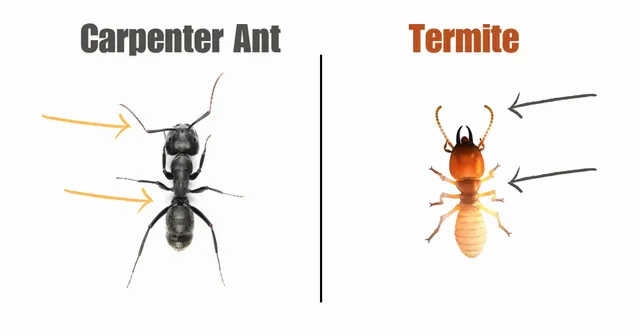Carpenter Ants or Termites?
Identifying the Pests in Your Space
Carpenter Ants vs. Termites:
Key Differences You Should Know
When comparing carpenter ants and termites, it’s easy to see why people often confuse the two. While they may share some similarities, such as being pests that can damage wood in your home, there are several distinct differences between them. Understanding these differences can help you identify which pest is causing the problem and determine the best course of action. If you’re unsure, it’s always a good idea to reach out to a professional pest company like Olympia Pest Control By Bamboo to assess the situation and prevent further damage.
Appearance: Size, Shape, and Color
The physical differences between carpenter ants and termites are some of the easiest ways to tell them apart:

- Body Shape and Size: One of the quickest ways to differentiate between the two is by looking at their bodies. Carpenter ants have a narrow, defined waist that separates their upper and lower body segments, giving them three distinct body parts. In contrast, termites have a more uniform body shape, with no defined waist, and they are divided into only two main body sections.
- Antennae: Carpenter ants have elbowed antennae that bend outward before pointing forward. On the other hand, termites have straight, bead-like antennae that lack any angles and often droop downward.
- Wings: If the insect you’re dealing with has wings, there are key differences to note. Carpenter ants have two wings on each side, with the front pair being noticeably larger than the hind pair. Termites, however, have four wings of equal size, and their wings tend to be uniform in length and shape.
- Color Variations:
The color of these pests also varies. Carpenter ants are typically black, brown, or even reddish, depending on the species. Termites, however, often have a more translucent appearance, ranging from cream to pale white. Some termites, particularly those in the worker caste, can even appear almost completely white.
Behavior and Habitat
While both carpenter ants and termites can damage wooden structures, their behavior is quite different. Carpenter ants don’t actually eat wood—they burrow into it to create nests. Termites, on the other hand, consume wood as a food source, which can lead to far more extensive damage over time.
Identifying the Pest in Your Home
Understanding the distinctions between carpenter ants and termites can help you determine the best course of action if you find signs of an infestation. If you’re still uncertain about which pest you’re dealing with, contact
Olympia Pest Control By Bamboo to get professional advice and ensure your home is protected from further damage.
Behavioral Differences Between Carpenter Ants and Termites
While both carpenter ants and termites are drawn to wood, how they interact with it is a key difference that often confuses homeowners. Understanding their behavior can help you determine which pest you’re dealing with and how serious the problem might be.
Termites: Wood Eaters
Termites are notorious for consuming the wood they live in, which is why they’re often considered a much more destructive pest than carpenter ants. Termites feed on wood as their primary food source, causing significant structural damage over time. If left untreated, they can chew through crucial support beams, leading to severe issues like sagging floors or weakened ceilings. A common sign of termite damage is the appearance of what looks like water damage, even when there’s no actual water present. This can manifest as warped wood or soft, sagging floors, often mistaken for water-related issues.
Carpenter Ants: Wood Nesters
Carpenter ants, on the other hand, use wood primarily for shelter rather than food. While they may chew through wood to create their nests, they don’t consume it the way termites do. Instead, they’re often attracted to human food, which is why you might find them foraging in your kitchen. Although they do create tunnels in wood to build their nests, the structural damage they cause is typically much less severe compared to termites.
Locating Carpenter Ants vs. Termites
Finding these pests also differs. Carpenter ants are usually easier to detect because they frequently leave their nests in search of food. During their movements, they may leave behind small piles of wood shavings and frass (their waste), which can be a telltale sign of their presence.
Termites, on the other hand, are much more secretive. They rarely leave their nests and often go undetected for long periods of time, quietly consuming the wood inside your walls. Their ability to remain hidden, combined with their constant appetite for wood, makes them a much bigger threat to your home’s structure in the long term.
If you suspect you have either termites or carpenter ants, it’s important to act quickly. While carpenter ants can cause damage, termites are far more destructive and can compromise your home’s stability. Olympia Pest Control By Bamboo can help identify which pest is causing the problem and provide effective solutions to protect your property.

Key Differences in Carpenter Ant and Termite Infestations
If you're trying to figure out whether you have carpenter ants or termites, there are some clear signs that can help you distinguish between the two. It's always a good idea to get a professional pest control expert involved if you're unsure, as both of these pests can cause issues if left unchecked. Here are some of the primary differences to look for:
Sawdust and Frass (Waste Material)
Carpenter ants create visible waste known as frass, which looks like fine sawdust. As they burrow into wood to make their nests, they push out this frass, and you may find small piles of it near the entrances to their nests. Termites, however, leave no such wood shavings or frass because they consume the wood they infest. All the wood they chew through is digested and used as food, leaving no visible waste behind.
Mud Tunnels
One of the most obvious signs of a termite infestation is the presence of mud tunnels or tubes. Termites build these hardened earthen tunnels to travel safely from their underground nests to aboveground food sources, like the wood in your home. You might spot these mud tubes on the exterior foundation of your home as termites search for entry points. Carpenter ants don’t build these mud tunnels, so their absence could be a clue that you’re dealing with ants, not termites.
Wood Damage
The type of wood damage you find can also indicate which pest is causing the problem. Termites eat through wood completely, leaving the inside of beams or furniture hollowed out and fragile. Carpenter ants, on the other hand, burrow into wood to create tunnels and chambers for nesting but don’t consume it as food. If you see wood with scattered holes or tunnels, it’s likely the work of carpenter ants.
Handling Carpenter Ant and Termite Infestations
If you suspect either carpenter ants or termites, it’s important to contact a pest control professional as soon as possible. Termites can cause significant structural damage to your home, and the longer they go undetected, the worse the damage becomes. Termites are known in the construction industry as “schedule killers” because they can cause unexpected delays and costly repairs during remodeling projects.
Carpenter ants, while less destructive than termites, can still be a serious problem if left unchecked. Their colonies can grow, potentially leading to larger infestations that may compromise parts of your home and even bring health risks to your family.
If you’re in Olympia, WA, Olympia Pest Control By Bamboo is here to help. Our team can assess the situation, determine whether you’re dealing with carpenter ants or termites, and implement effective solutions to protect your home. Check out our FAQ guide for more information about how we handle common household pests and what pest control services we offer.
For service call: 360-323-5760
Copyright © 2024 - Olympia Pest Control by Bamboo All Rights Reserved
